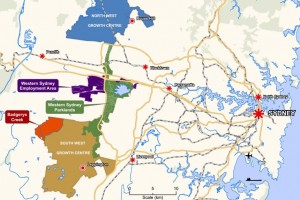After decades of argument, procrastination and deeply democratic consultation, Sydney is finally moving ahead with its urgently needed second airport. Located at Badgery’s Creek in Western Sydney, the airport will drive social and economic change in the local area and underpin growth in Sydney and NSW in general. Work has commenced with the airport planned to be operational in the mid 2020s.
As a state-of-the -art hub for air freight, the airport is expect to enable new export oriented and internationally facing businesses in the Southwest Growth Centre and Western Sydney Employment Area.
Sydney’s existing airport, located in inner city Mascot, is subject to highly restrictive noise curfews. While some citizens are concerned about the impacts of aircraft noise from Badgery’s Creek, the noise corridor has largely been preserved from development so the airport should be able to operate 24/7 without significant impact on amenity.
The benefits in terms of transport logistics and general economic efficiency are immense. The city fringe location will help solve Sydney’s chronic transport problems, enabling the redirection of freight and Western Sydney business traffic away from the city centre.
Western Sydney is already Australia’s largest manufacturing region with around 8,500 manufacturing companies generating approximately $13.5 billion annually. If everything goes to plan, the new airport will help these firms and firms entering the region to achieve new levels of productivity.
While all of Sydney will benefit from the economic boost, it is anticipated that higher value employment opportunities in the area will have flow on effects for local communities, improving both the quality of housing and the general standard of amenities. In anticipation of the increased activity and population, the State and Federal Governments are funding new road and rail infrastructure and a suite of major urban development and growth programs.
Over the next decade it will be interesting to monitor how social change and gentrification driven by the airport impact Western Sydney property and to see which locales benefit the most. Western Sydney has always been overshadowed by the beauty of Sydney Harbour and the coastal suburbs but it has many attractive natural features, including spectacular parks along the Nepean River and in the Great Dividing Range, which borders the district.
Significant capital gain has been seen over the past 12 months right across the West, particularly along the existing rail corridors. To the North of the airport site, Mount Druitt, which currently suffers from high unemployment and relatively low housing standards, has seen a 20% annual increase in median price. To the south, the posh, rural residential Camden – a locale noted for private estates – has achieved a 16% annual gain in the same period. These gains, of course, are in the context of a generally hot Sydney property market so the real test will come when the market cools down (surely it must at some point!).

